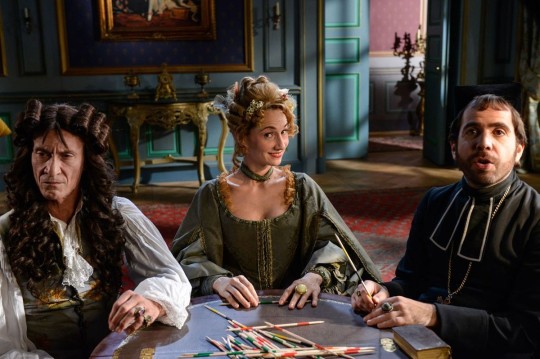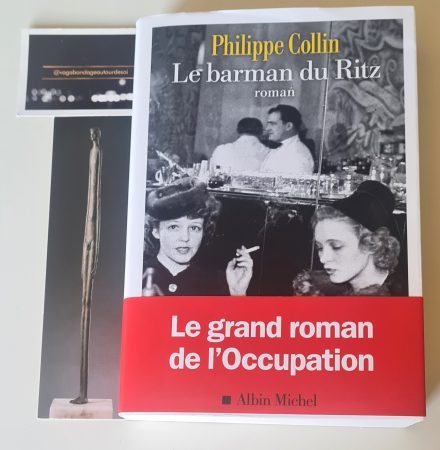#Histoire de la France
Explore tagged Tumblr posts
Text
youtube
petite histoire poétique de la France, résister
Avant les tristes années de l'Armée des ombres, il n'y a eu aucune reconnaissance pour leur soutien, leur possible réconfort. Un début de justice pour ces figures de l'absence matérialisée ?
L'ombre, la grande victime de ces siècles derniers, de nos civilisations ignorantes !
Le peuple des Ombres est celui qui résiste.
.
(Dans la portée des ombres, extrait)
© Pierre Cressant
(vendredi 21 octobre 2005)
#poème#poésie#poésie en prose#prose poétique#poètes sur tumblr#french poetry#poésie contemporaine#poème en prose#dans la portée des ombres#l'armée des ombres#jean-pierre melville#petite histoire poétique du cinéma#peuple des ombres#résistance#seconde guerre mondiale#Eric Demarsan#petite histoire poétique de la france#Youtube
8 notes
·
View notes
Text

« Vous en êtes comme malade de votre désir d'en savoir toujours davantage... Voilà tout... Enfin, ça doit être votre chemin à vous... Par là, tout seul... C'est le voyageur solitaire qui va le plus loin. Vous allez partir bientôt alors ? »
Voyage au bout de la nuit - L-F Céline (1932).
#louis-ferdinand céline#céline#voyage au bout de la nuit#roman#lecture#littérature#littérature française#france#french#french litterature#citation#livre#réflexion#1932#culture#histoire
11 notes
·
View notes
Text
🏰Château de la Mothe Chandeniers fête Noël🎅
Vidéo 👇
youtube
Photos 👇










#castle#château#mothe Chandeniers#france#nature#explore#chateaudelamothechandeniers#exploration#noël#fêtes#ruines#les trois moutiers#night photography#my photgraphy#photography#youtube shorts#youtuber#photograhers on tumblr#visit#histoire#patrimoine#dartagnan#Youtube#illumination#vienne#chateau de la mothe chandeniers
5 notes
·
View notes
Text


sir this is a wendy's
#konan iv#twelfth century#i was like wait this sounds like de la borderie and well well well guess who!#i was trying to find a passage on conan ii actually but this stopped me in my tracks lol#quaghebeur and desbordes make a good case for why these are not really comparable in terms of contexts#but man they were not kidding when de la borderie writes like conan4 killed his dog#god forbid you bring up conan iv to someone in the 1870s and they start talking about the glory of mother france or some shit#histoire de bretagne by arthur de la borderie
3 notes
·
View notes
Text

"The Vichy regime incorporated the forest into its ‘back-to-the-land’ programme constructing the forest as a traditional, stable site in which to morally regenerate France. Jacques Chevalier, conservative philosopher and minister for public instruction between December 1940 and February 1941, considered that ‘life in the forest is the most healthy there is for the body and the soul, freeing us from the artifices of modern society’. He suggested that ‘eternal’ France resides in the forest. The forest constituted:
A living symbol of tradition, perpetuating history; old France is preserved better here than anywhere else; the present unites effortlessly with the past. In the silence and depth of the forest centuries replace one another, slowly, continuously, in the same way that the oak’s sapwood binds a new layer to those of springs and autumns past.
For Chevalier, trees represented a link between France’s past and present and acted as a guarantor of French traditions. Chevalier’s musings on trees and tradition are by no means uncharacteristic of the symbolic appropriation of trees. In the words of Douglas Davies, the tree is ‘a living entity, spanning many human generations. As such it avails itself as a historical marker and social focus of events’.
Forestry associations strove to incorporate the forest within the ‘National Revolution’. Just after the defeat, J. Jagerschmidt, the general secretary of the Comité des forêts argued that the forest was a ‘refuge of [the] old principles’ of Work, Family, Homeland. For Jagerschmidt, the forest epitomised the virtues of labour because ‘woodcutters and charcoal burners laughed at the paid holidays and forty hour week that the [Third Republic] wanted to impose on them’. Forest workers did not need to be told to work ‘from sunrise to sunset’. Family and forest also went together, according to Jagerschmidt, because the latter was a
symbol of tradition . . . of which the evolutionary rhythm exceeds several times the length of human life, [so] chimes perfectly well with the notion of the family, the linking of successive generations.
Furthermore, it was in the depths of the forest that the country’s ‘heart’ belonged. It is unclear whether such rhetoric represents deeply held beliefs or lip service to the newly installed regime. Either way, the forest’s politicisation is evident. The irony was, however, that such ‘back-to-the-land’ rhetoric simultaneously politicised the forest and constructed it as a space of ‘natural’ (and therefore apolitical) values and traditions
In a similar way to the peasant, the bûcheron (or woodcutter) was transformed into a patriotic figure labouring to regenerate France. Working in the forest helped strengthen male bodies and remake masculinity in post-defeat France. Two state foresters, Roger Blais and Gérard Luzu, published a guide to the ‘tough school’ of the forest, which presented forestry work as the most ‘radical’ return to the land and ‘an integral part of rural reconstruction’. They highlighted the ‘physical and moral enrichment’ the forester gleaned from the forest, ‘contributing to the affirmation of values and personal autonomy within the framework of nature’s laws and collective life’. In contrast to the ease of city living, life in the forest was ‘hard and healthy’ and woodcutting a ‘noble and free occupation’. Blais and Luzu also called for the forestry profession to conform to the principles of ‘social spirit and true hierarchy as outlined by the head of state’. Similarly, a 1943 article in Revue des Eaux et Forêts argued that ‘living in nature’ is the ‘best school’ and working in forestry teams countered individualism and selfishness because it cultivated the qualities of ‘sacrifice and charity’. These visions of forest life chimed with Vichy’s assumption that hard work was redemptive and served a national purpose.
Likewise, the forestry work of the Chantiers de la Jeunesse was supposed to contribute to male moral and physical regeneration. The Chantiers leadership viewed the forest as a safe and wholesome place, distant from the supposed immorality and decadence of modern society that reached its zenith in the city. From the outset, the Chantiers strove to remove its recruits from the ‘deleterious influence of the towns’ by making them camp out ‘in the great outdoors (en pleine nature), in the middle of the forest, hidden from all forms of trouble or agitation’.
The forest supposedly held important lessons for these young men, as it did for the rest of society. At Tronçais, Group One of the Chantiers dedicated a tree to their leader, Commissaire Furioux. In his speech during the ceremony, Forestry Inspector Desjeux pronounced that
it is through the living example of the forest, an example of tradition, continuity, and grandeur that [Furioux] wanted to impress on all those who had the honour of obeying [his] orders.
In a similar vein, Forestry Conservator Pascaud used his speech to identify the forest’s exemplary demonstration of ‘solidarity’. In particular, the oak tree towering serenely above surrounding trees protects them so that they grow to share the ‘light in which he bathes’. Addressing the Chantiers, Pascaud continued:
This solidarity of all plants, is it not the image of the best of societies where the leader must dominate in his pre-eminence while feeling himself surrounded, supported, [and] aided [by his followers]? If his entourage fails him, he succumbs, whatever his qualities. Let us remember this example at a moment when divisions lie in wait for us.
There was, however, some discrepancy between the regime’s rhetoric and the reality of forest life. The Chantiers’ leaders were well aware of the young men’s indifference, even outright hostility, to their new role as woodcutters. A 1943 report lamented that the Chantiers’ early enthusiasm and their ‘mentality of explorers out to discover new lands’ had since dissipated. Instead, the men no longer recognised the ‘usefulness of their work’ and the leadership itself admitted that ‘forestry work, interesting at first, quickly becomes monotonous, [and] tedious. Their hearts are not in the felling. Boredom is the dominant characteristic’. The joys of being a woodcutter were lost on those forced to work in the forests.
Nonetheless, the image of a stately oak leading and protecting his followers was a popular one. Yvonne Estienne’s illustrated children’s story La belle histoire d’un chêne (1943) compared France to a forest that had just been struck by a fierce storm. During the storm, trees swayed alarmingly in the wind and petrified birds and animals rushed to find shelter 'all the forest is unhappy. It looks for help’. Help came from the forest’s leader, a ‘tall, solid, upright tree’ who fears nothing and protects its charges. In case her young readers had missed the analogy, Estienne moved the story onto contemporary events: during the military defeat the French had fled from the enemy and its bombs ‘like the rabbits of the wood’. But luckily for France there was hope:
there existed, as well, in the forest of France – because men [sic] resemble trees – a tall, beautiful oak, already old but so valiant that he stood strong to protect everybody. And this tall, beautiful oak was called Marshal Pétain.
Helpfully, the Pétain oak tree carefully explained where the forest had gone wrong and how it should reform itself.
Vichy’s ideological appropriation of the forest reached its high point in Tronçais where an oak tree was named after Pétain on the initiative of Chevalier (his godson) and in the presence of forestry officials. Like the supposedly exceptional qualities of Pétain, the oak tree chosen to bear his name stood out from the rest: it stood 35 m high, was 260 years old and boasted good foliage. During the naming ceremony, Pétain unveiled a plaque bearing the words ‘Chêne Maréchal Pétain’ and made three marks on the tree with a Forestry Administration hammer. On one level, this event can be interpreted within the framework of the cult of personality created around Pétain, who admitted that he hoped that he would be able to ‘remain as upright as this tree in order to be able to devote [himself] to the service of the country’. The ceremony also implied that Pétain, like his oak tree, embodied the latest in a vulnerable line of strong, upright men devoted to France. As Chevalier asked during the ceremony; ‘who could doubt a country which produces such trees and such men?’
But beyond the construction of Pétain’s cult of personality, it is not too fanciful to see this marking of the tree as a performative device to reinforce the importance of the forest and the state’s claim to govern it. The occasion also served as a reminder of the forest’s historical role as ‘saviour’ of France. During the ceremony, Chevalier reminded his audience that this ancient forest provided wood for the Navy in 1793 and timber for the Army in 1917. Caziot, in a speech prepared for the ceremony, also emphasised the forest’s role as a productive space of ‘exceptional value for the material reconstruction of the country’. Now that France had crumbled under German invasion, forests would enable the nation to recover its former glory.
The ceremony suggested that Tronçais, which the state had replanted in the late seventeenth century, was physical evidence that France could rebuild itself under Vichy’s guidance. Caziot called for a contemporary display of determination equal to that of foresters who had replanted Tronçais:
The state of the Tronçais forest in 1670, was it not the image of France today, of the ravaged France, morally demolished by more than half a century of hideous demagogy? The war then added its own disasters. Today, everything must be remade, morally and materially. It is a fearsome task and one which demands long and patient effort as the rot runs deep. But the base has remained healthy and solid and allows for hope . . . On this solid base, which is the foundation of France, we can, in the image of Tronçais, remake a vigorous and healthy France. The oak which bears [Pétain’s] name must be a lesson and a symbol for everyone.
In this speech, Caziot compared the Third Republic with the damaged pre-1670 forest, but suggested that all was not lost because the forest’s essential nature (like France’s) had remained intact. There is also a sense that the forest’s and France’s ‘true’ essence lay beneath the surface of democracy and modernity, waiting to be recovered and restored. This speech was a manifestation of the right-wing idealisation of ‘True France’, which, as Herman Lebovics suggests, relied on a ‘discourse [that] employs the essentialist determinist language of a lost hidden authenticity that, once uncovered, yields a single, immutable national identity’.
Yet the forest’s political symbolism need not be reactionary. Vichy’s appropriation of the oak tree echoed previous state manipulation of this species. Ironically, given Vichy’s hostility to the French Republic, in the years following the French Revolution oaks were moulded into ‘Liberty Trees’. Like Vichy, revolutionary governments elevated the oak to the status of a ‘beacon tree’ controlling and sheltering surrounding trees. Moreover, French resistance units occupied the forest’s physical and symbolic space, transforming it into a site of resistance.
As the Occupation dragged on, resistance fighters identified the forest as a place to seek refuge and a base from which to oppose the Vichy regime and the German occupier. In places this development manifested itself symbolically. At Tronçais in February 1943, a resister reportedly scaled Pétain’s oak, replacing the plaque bearing the Marshall’s name with the following:
Chêne Gabriel Peri French Patriot Shot by the Nazis
Consequently, Pétain’s oak is now officially known as the ‘Oak of the Resistance’. But beyond this symbolic act, the resistance reclaimed the forest in more material ways." - Chris Pearson, Scarred Landscapes: War and Nature in Vichy France. New York: Palgrave MacMillan, 2008. p. 56-61.
#world war ii#occupied france#vichy france#régime de vichy#forêt de tronçais#l'allier#forêt domaniale#environmental history#histoire de france#research quote#reading 2024#national revolution#oak tree#reclaiming youth#forestry#revoluntion nationale#back to the land#chantiers de la jeunesse#marshal pétain
5 notes
·
View notes
Text

Les Mémoires de Louise Michel : Un ouvrage essentiel pour comprendre l'histoire du mouvement ouvrier et du féminisme.
#louise michel#Mémoires de Louise Michel#la commune de paris#histoire de france#révolution#anarchisme#féminisme
1 note
·
View note
Text



Jeu de pétanque la mollette
2 notes
·
View notes
Text
speech writing going so so so bad

#get me out of here this week has been so so so exhausting for many reasons and it's Not Over i Hate saturdays#tomorrow is going to suck when will redacted return from the war (france)#i feel like pierre bezhukov rn i too wish i were there with death at my heels#(in france)(the war)#i have like 2 days to write this speech but really i have like. right now and sunday et lundi pour la faire#et my brain a arreté functioning suddenly. maybe it has to do with When You Do Things All Day And Dont Rest Your Brain Goes Bad.#je veux seulement écrire mon histoire de la maison hantée#in the words of paul simon: oh lord why have you forsaken me#oh AND i barely got to talk 2 my mommy today.... :(#daffodil lamenting
3 notes
·
View notes
Text
La petite histoire de France


Grant Lawrens : Baptiste

David Salles : Jean Plancher cousin par alliance de Napoléon, Karina Marimon Renata Plancher cousine de Napoléon et femme de Jean


François Levantal : comte Philippe Honoré de Roche Saint-Pierre cousin de Louis XIV, Anne-Sophie Girard : comtesse Marie-Louise de Roche Saint-Pierre femme de Philippe, Philippe Beglia : Frémont majordome des Roche Saint-Pierre, Sébastien Castro : abbé Martin, Jean-Luc Couchard : Feuillade, Émissaire du Roi et ami des Roche Saint-Pierre qui leur apporte des nouvelles de Versailles, et leur fait toujours de fausses joies



Alban Ivanov : François d'Arc, cousin de Jeanne d'Arc, Ophélia Kolb : Ysabeau d'Arc épouse de François d'Arc, Fatsah Bouyahmed : Gaspard le gardien de brebis, Philippe Duquesne : Adelin beau-frère et ami de François d'Arc, mari de Guillemette père d'au moins 10 enfants
6 notes
·
View notes
Text
La mode, tout le monde assure ne pas la suivre, mais chacun la subit.
Ines de la Fressange
0 notes
Text
sur la chaussée des vides qui jouent avec la lumière ; l’enfant y voit l’innocence d’un puzzle à combler ; l’adulte sait que le pavé manquant est la marche d’une révolte en cours ; le révolté sait que ce vide est déjà une défaite, un droit vaincu qui a existé dans un passé qui était hier
© Pierre Cressant
(samedi 15 avril 2023)
#poètes sur tumblr#poésie#poème en prose#poésie en prose#poème#poètes français#french poetry#droit#histoire des droits#petite histoire poétique de la france#petite histoire poétique du monde
19 notes
·
View notes
Text
La cuisinière des Kennedy de Valérie Paturaud
As-tu également été bercé.e au rêve américain, aux histoires de succès éclatants à la Bernard Tapie, aux paillettes et à la jet-set ? Pour ma part, un peu, surtout à travers le magazine Paris Match que mon père rapportait à la maison chaque semaine. Les Kennedy sont indéniablement l’une des familles les plus exposées médiatiquement depuis les années 50. Même si leur présence est moins marquée de…

View On WordPress
#2024#Abandon#amitié#Assistance publique#Autrice française#Biographie romancée#Cuisine#Destin#Editions les Escales#Etats-Unis#Famille#Femme#France#Histoire#Kennedy#La cuisinière des Kennedy#Liens#Littérature française#littérature générale#Parcours de vie#Président des USA#Pupille de la nation#Roman#Roman historique#Valérie Paturaud
0 notes
Photo

DES FORÇATS ONT QUITTES LA ROCHELLE De nombreux forçats sont partis mercredi dernier de l'Ile de Ré pour le bagne. Notre photo montre un convoi quittant La Rochelle a destination de l’Ile, l'homme au chapeau mou est Castaner, danseur mondain, qui tua un de ses camarades. (Voir page 12.)
- Police Magazine. 2ieme année - n° 42. 13 Septembre 1931
#la rochelle#bagne#penal colony#convict transportation#ile de ré#maison centrale#citadelle de saint martin de ré#french guiana#guyane#history of crime and punishment#carceral archipelago#histoire de france#french prisons
1 note
·
View note
Text
Philippe Collin - Le Barman
Présentation du premier roman de Philippe Collin, Le barman du Ritz, sur le grand hôtel de l'entre-deux-guerres à la fin de la seconde guerre mondiale.
Du Ritz Philippe Collin prend à bras-le-corps la vie de Franck Meier pour nous la proposer à sa lumière. Et, cette vie, exceptionnelle, devient savoureuse tant l’historien journaliste aime recréer, en sept parties, l’ambiance de l’époque de l’entre-deux-guerres jusqu’à la fin de la seconde guerre mondiale. Le bar élégant du Ritz évolue sous nos yeux avec ses privilégiés, artistes, banquiers ou…

View On WordPress
#Alcool#Alcoolisme#Billet littéraire#Biographie#Biographie romancée#Bric à brac de culture#Chronique littéraire#Chronique livre#Chroniques littéraires#Collaboration#Guerre#Hôtellerie#Histoire de France#Histoire de l&039;Europe#Histoire de la Ville de paris#Histoire de Paris#Histoire du XXè s#Littérature contemporaine#littérature française#Littérature francaise#Litterature contemporaine#Luxe#Premier roman#Résistance#roman#seconde guerre mondiale#Seconde guerre moniale
1 note
·
View note
Text

Citation attribuée à De Gaulle par André Frossard.
Le Sursaut, Histoire intime de la Ve République
1 note
·
View note
Text
Louise et Denise Boute, une histoire de syndicalisme et d'égalité des hommes, et femmes.
Le monde de l’entreprise est un monde où l’on cherche bienveillance, solidarité, entre-aide. Le bien vivre ensemble ! Respecter chacun, dans sa diversité. Hommes et Femmes, personnes d’origine étrangères, homosexuels, handicapés… La longue histoire de ma famille s’est ancrée dans ces valeurs de solidarité. Madeleine Singer, historienne de la CFDT, retrace ici son histoire. Louis Boute et…

View On WordPress
#histoire CFDT Madeleine Singer#histoire de la CFDT#histoire du syndicalisme textile#histoire textile Nord CFDT#militantisme ARFEM#résistance seconde guerre mondiale Armentières#section syndicale ANPE France Travail histoire
0 notes